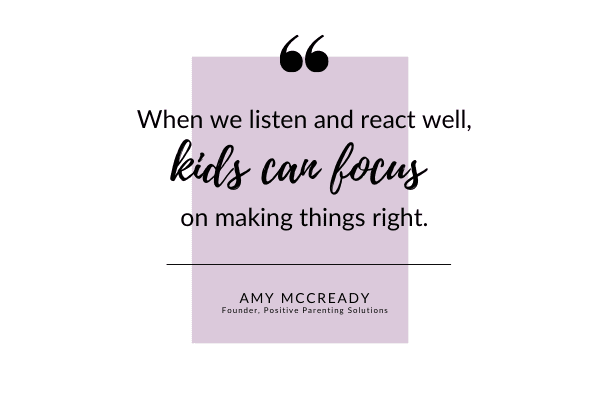How to Parent a Bully: Why Kids Bully & 6 Actions to End It

It’s 10 AM on a Tuesday. You’re finally accomplishing some long put-off work when your cell rings.
It’s the school. Oh no, is he sick? It’s already the third time this year.
But it’s not the school nurse. It’s an administrator. And, when she starts to speak, your heart skips a beat.
There’s been a bullying incident. Everyone’s okay, thank goodness. But as the conversation continues, your heart begins to sink.
Your son’s social challenges spiraled out of control, and he took it out on another student…
Parenting has never been harder.
A lot of attention goes to kids who are the targets of bullying, and rightfully so. It’s a crucial issue that schools and families are working diligently to tackle.
But on the other side are those labeled as the bullies and their families. They may receive far less sympathy but are equally distraught. They are experiencing endless questions, blame, and shame.
At Positive Parenting Solutions, we know the word bully is emotionally charged. It is an unnecessary, highly destructive label that makes kids feel even worse about themselves, and it affects the way parents and other adults interact with the child.
(NOTE: In this article, we will not use the word “bully” as a label for a child–we will only use it as a verb to describe the “act of bullying.” Instead, we will refer to the challenging behaviors these kids are presenting.)
Hearing the news that your child has been unkind or aggressive may make you bewildered, embarrassed, sick to your stomach, and even defensive. Quite possibly, you have no idea what to do next.
Admitting there’s a problem is the first step, and finding the reason behind this behavior comes next. In fact, before we go further, our FREE ONLINE CLASS reveals the source of misbehavior and how to deliver–when necessary–consequences that are efficient and effective.
If you are a parent or family dealing with this difficult scenario, it IS possible to navigate it with confidence, dignity, and courage. Your kid isn’t a bad kid or destined for trouble. He or she simply needs some loving, positive guidance!
But, before we can help our kids make good choices when it comes to bullying, we need to understand why kids feel the need to take their frustration–whether from a lack of social awareness, deep-seated insecurities, violence they’ve dealt with in their own lives, or a host of other issues–out on other children.
Why Some Kids Bully
Bullying is as old as time, but we know that doesn’t make it okay. It’s our job as parents and as a society to make the world better for everyone–even if that means combatting something widespread.
Some experts assert that aggressive behavior may have evolutionary roots. But, based on a child’s circumstances and environment, it is most certainly an environmental/learned behavior, too.
According to Stomp Out Bullying, kids can become more inclined towards intimidation when they:
- Wrestle with emotional issues
- Feel insecure/powerless/lack attention
- Are bullied by someone else
- Have social difficulties
- Lack empathy
If you’re worried your child may be wrestling with these issues but aren’t quite sure, here are some red flags to watch out for:
Signs Your Child is Struggling to Manage or Recognize Emotions
According to StopBullying.gov, there are multiple indications your child is becoming confrontational. These behaviors may include:
- Getting into physical or verbal fights
- Hanging out with friends who bully others
- Acting increasingly aggressive
- Getting sent to the principal’s office or to detention frequently
- Having unexplained extra money or new belongings
- Blaming others for their problems
- Not accepting responsibility for their actions
- Competitiveness and worrying about their reputation or popularity
If any of these behaviors are noticeable, it’s a good idea to try to talk to your child about things that could be bothering them. You can also reach out to the school if maintaining open communication is difficult.
And be aware that these behaviors start young! According to Joel Haber, PhD, a bullying prevention expert, negative social behaviors can begin “…when kids start relating to each other, which can start at age two or three. We see at three that girls pair off to become best friends and exclude another. That’s at three years old. So by the time they get to elementary school and middle school, they’re pros.”
Why Bullying Is So Harmful
Bullying is never something to take lightly. In fact, society is finally beginning to recognize that it’s an issue that must be dealt with. The impact can be truly devastating.
Adverse Childhood Experiences
When measuring the impact of early trauma, or ACEs (Adverse Childhood Experiences), bullying plays a huge factor.
ACEs can affect children their entire lives, impairing their mental health, relationships, and quality of life.
It Creates a Vicious Cycle
Bullying commonly ricochets to more bullying. A child bullied by a friend or a parent is more likely to show aggression towards another child at school.
When we stop bullying in its tracks, it can prevent exponential harm.
How to Help Your Child (and Prevent Future Bullying)
We’ve learned that kids who choose to intimidate others are often lacking something. The question is, as parents and caregivers, how can we fulfill what they need? Especially when they take negative feelings out on others?
1. Focus on Discipline, not Punishment
At Positive Parenting Solutions, we talk a lot about the difference between discipline and punishment. The distinction is crucial!
According to Jane Nelsen, the author of Positive Discipline, the most basic explanation is that punishment, like spanking, is anything that inflicts blame, shame and/or pain. It is a reactive, rather than proactive, response to a misbehavior, and it doesn’t teach kids why certain behavior is wrong or how to act differently next time.
And, what’s equally detrimental–it turns their anger towards you and others.
Discipline, on the other hand, correlates misbehavior to its outcomes without unnecessary negativity. In fact, well-engineered logical consequences teach kids that their own actions dictate results–all with respect and without judgment.
It may seem counterintuitive, but misbehaving kids need more love and understanding than ever. Yes, they may need to face discipline and consequences, but punishment? Never! That will only make things worse.
Here are some tools to try immediately with EVERY child–especially one singling out other kids to pick on or otherwise harm.
2. Commit to Mind, Body, and Soul Time® activities
As mentioned earlier, many kids feel insecure, powerless, and a lack of attention. And, according to Adlerian Psychology (which provides the basis for positive parenting) all children crave a sense of belonging and significance.
Yes. Aggressive kids may seem rough, tough, and unruly, but in many cases, that hard exterior is just a lack of feeling emotionally connected and knowing they matter. They may be suffering from a lack of positive, one-on-one time and attention with mom and dad.
Mind, Body, and Soul Time® togetherness is the most important tool in positive parenting, because, when a child feels a deep emotional connection with his parents or caregivers, we fend off a tremendous amount of misbehavior from occurring in the first place.
Really?? REALLY!!
When we talk about targeting the root source of misbehavior, Mind, Body, and Soul Time hits a bullseye. It tells kids they are valued, loved, and respected despite their failures and shortcomings–maybe even because of them. It gives them power, attention, and a sense of security, all of which so many kids lack!
This tool is best used EVERY.SINGLE.DAY. But, it doesn’t have to be a huge time suck. Even 10-15 minutes once or twice each day, one-on-one between each parent and each child will work wonders. It just has to include bonding over something the child chooses to do.
It also opens doorways towards increased communication. You may find out your daughter is acting aggressively because she’s being bullied by someone else. Or, maybe your son is having social difficulties and doesn’t feel like he fits in.
In a safe space, kids can open up about anything. Contrarily, when we don’t focus on our time and relationships with our children, we have less insight into their lives.
3. Create a Decision-Rich Environment
Another way to give kids a sense of power is to create a Decision-Rich Environment in your home.
Kids that feel powerless typically receive a lot of ordering, correcting and directing from their parents. They may not be allowed a voice or as much input as they’d like.
You may be saying, “Wait a minute…aren’t I the boss?”
Of course you are! But, all human beings, big or small, need to have some power over their lives. That’s why we can create situations where our kids make age-appropriate decisions and know their opinions matter.
Maybe, after the implementation of a new after-school routine, you’ve noticed your 10-year-old being mean to her younger sister. Take a look at the new schedule–is there room there for your older daughter to make some more decisions? She could be feeling constrained and powerless.
You can allow her to choose between outfits for school, decide what she’d like to do in her free time, and/or allow her to choose which homework subject she completes first.
For younger kids, even as young as two or three, you may begin noticing playground aggression. Kids may feel powerless when they’re forced to share toys, told they can’t go up the slide, or asked repeatedly to wait their turn. Among a million other things.
While kids still need to learn appropriate playground behavior, we can give them other playground choices to make them feel less “bossed around.” They can decide which snacks to bring for the playground picnic, or tell you which friend they’d like to invite for a play date. They can choose the toys they’d like to play with, and whether they’d like you to push them on the swing now, or later.
The bottom line is…the more opportunities we give kids to make age-appropriate choices and to have some dominion over their own lives, the less likely they are to seek power over others.
4. Withhold the Judgment
Kids are more likely to open up about misbehavior–or avoid it altogether–when we eliminate judgment.
Responding calmly, listening well, and not rushing to conclusions makes kids less afraid to come to us when they’re in trouble. Withholding judgment also makes them less likely to lie.
Kids like to avoid our disappointment and potential punishment, so in their minds, lying can be as good a tool as any to sidestep negative reactions and situations.
But, when we listen and react well, there’s less concern over making things worse. Instead, kids can focus on making things right.

5. Set a Good Example
Parents set the standards for their kids. We’re the role models, always modeling the correct way to treat people. Kids learn the most when they’re at home observing us.
Teaching an appropriate attitude towards others means following the golden rule and treating others the way you want to be treated. It’s exhibiting inclusivity and empathy with friends, family, even strangers.
It’s true that many quarrelsome kids come from families struggling with hardship, emotional issues, power imbalances, and trauma. So, making sure each child’s home environment is safe, loving, and supportive is equally crucial.
6. Focus on Gratitude and Empathy
If your child has become combative at least partially because of a lack of empathy for others, it’s time to give a good dose of perspective.
Volunteering for those less fortunate is always a way to expand a child’s awareness. It turns apathy and “what’s in it for me” into helping others because it’s the right thing to do–and it makes them feel good.
It’s seeing the world from someone else’s perspective.
We can also train kids to regularly consider what they’re grateful for. Daily gratitude journals are a great start.
Grateful kids are more likely to appreciate and understand why things are good in their lives. They’re less likely to take things for granted and more likely to understand the impact of negativity.
What About Tough Love and Adversity?
There can be benefits to hardship. Growing stronger, learning to manage pain, and problem-solving are all powerful examples.
The trick is knowing where to draw the line between helpful and harmful adversity.
As we’ve learned, we don’t have to punish kids through tough love to teach important lessons.
And kids don’t have to intimidate others to gain confidence and feel empowered!
Many parents embrace the philosophy that bullying and being bullied are a part of life. It’s unfortunate, but just another aspect of those everyday growing pains.
Sure, life won’t treat everyone fairly, and working through conflict does make kids tougher.
But turning a blind eye when a child harms others only decreases their capacity for empathy. And bullied kids don’t have to run the gauntlet to learn to stand up for themselves!
Final Thoughts
The quest to end bullying starts at the source. When we raise our kids with love, intention, and positive techniques, the impetus to antagonize others quickly deteriorates.
Don’t forget to involve teachers, counselors, family, and friends in your plans to stop bullying. If you’re concerned about your child’s mental health, or you aren’t seeing improvement with aggressive behavior, please consult a professional, too.
Parenting has never been harder–but there’s no reason to be disheartened.
What You Should Do Next:
1. Get Quick Actionable TIPS delivered to your inbox
Sign up for my newsletter for parenting tips to help you create a happier home and become the parent you always wanted to be. Plus, when you subscribe, I'll also send you a copy of our strategy-packed guide 10 Tips for Better Behavior – Starting NOW!
2. Unlock the secrets to easier parenting in my FREE CLASS
Register for my free class called How to Get Kids to Listen, Without Nagging, Yelling or Losing Control. Classes run several times per week to accommodate your busy schedule.
3. Transform your family with the 7-Step Parenting Success System® Course
Join the hundreds of thousands of parents who have transformed their families with the 7-Step Parenting Success System® Course. Learn the tools you need to raise happy, respectful, responsible kids and create the family life you always dreamed of having.
About the Author






